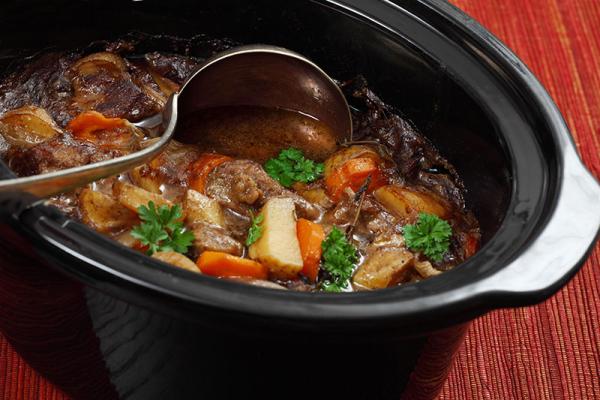Co-op Savings
Current Posts

Winter Slow Cooking
There’s nothing like walking into your house after a day at work (or on the slopes) to the smells of a home cooked meal brewing away.
To me, slow cookers seem a little bit like magic; in the morning, I slice and dice a few things, add this and that, hit a button and come home to a hearty dinner. Sometimes I’ve even forgotten that I’ve prepped it until I walk through the door and smell it simmering.
In the summer, my slow cooker tends to collect dust, as I fire up the grill most nights. But in the fall and winter, when warm meals matter most, the slow cooker is an essential piece of equipment in my kitchen, typically getting used at least once or twice a week.
Not sold on the slow cooker? Not sure how the heck to use one? Here are some slow cooker benefits, along with some tips and tricks for making the most of your slow cooker this winter.
Benefits of a Slow Cooker
Of course there are the obvious reasons, like throwing a meal in the cooker in the morning and coming home tired at the end of the day to a meal. But there are others.
Cook tough meats: Slow cooking is perfect for tougher (ahem, cheaper) cuts that need to be tenderized through slow cooking methods, such as stew meat, ribs or pork shoulder for pulled pork.
Feed a lot of people: A bigger slow cooker can feed the masses. If you’re having a party, a chili, soup or a pulled pork dish can go a long way.
Enjoy leftovers: If I’m cooking just for my household, I have leftovers for lunches or another dinner during the week and typically enough to freeze for one more meal when I’m feeling lazy. With some recipes, the meal tastes better the next day, after it's had more time for the flavors to develop.
Quick and easy: Most of the recipes you find in slow cooker books are easy and quick, at least the ones I choose. If it has too many ingredients or extra steps, such as cooking other ingredients first, I either bag that step or bag that recipe. (Unless it’s chili...always brown the ground meat first, which is a quick and necessary step.)
Transportable: Want to make a meal for a friend, bring something fast and easy to a potluck or office party? Fill it, cook it, bring it. Done.
Nutritious: A lot of slow cooker recipes involve meat but there are plenty that don’t. Whether it’s a meaty meal or a vegetarian lentil soup, I always add as many vegetables as I can.
Slow Cooker Tips
Keep it shut: Especially when a meal is on the low setting, try to open the lid as little as possible or not at all. Opening the lid lets heat out and can lengthen the cooking time.
Add some vegetables later: It’s best to add quick cooking vegetable, like spinach, kale and zucchini, to a slow cooker meal about 30 minutes before it’s done cooking, otherwise they will overcook and become mushy. However, more hearty vegetables are fine, such as onions, potatoes, peas, corn, peppers, etc.
Use smart layers: Although most of the recipes I like involve tossing everything together, in some cases layering matters. For instance, when I cook a whole chicken in the slow cooker, I put the vegetables, potatoes, onions, and carrots on the bottom and the chicken rests on top of that so it cooks on all sides.
Add dairy last: If a recipe calls for dairy, such as sour cream for a stroganoff, add it during the final 15 minutes of cooking, otherwise it will break down.
Remove fat: If you’re cooking a piece of meat, make sure to trim the fat off. Not only are you cutting down on the fat in the meal but you’re also limiting the oily, fatty flavors.
Don’t forget to turn it on: I’ve done this on busy mornings, and let me tell you, it’s a huge disappointment when you walk in the door and realize the whole meal is going into the trash.
Look online: There are thousands of slow cooker recipes online and Pinterest is a great way to store them.
Happy eating!

 Co-op West Main • Tuesday-8 am - 9 pm
Co-op West Main • Tuesday-8 am - 9 pm






